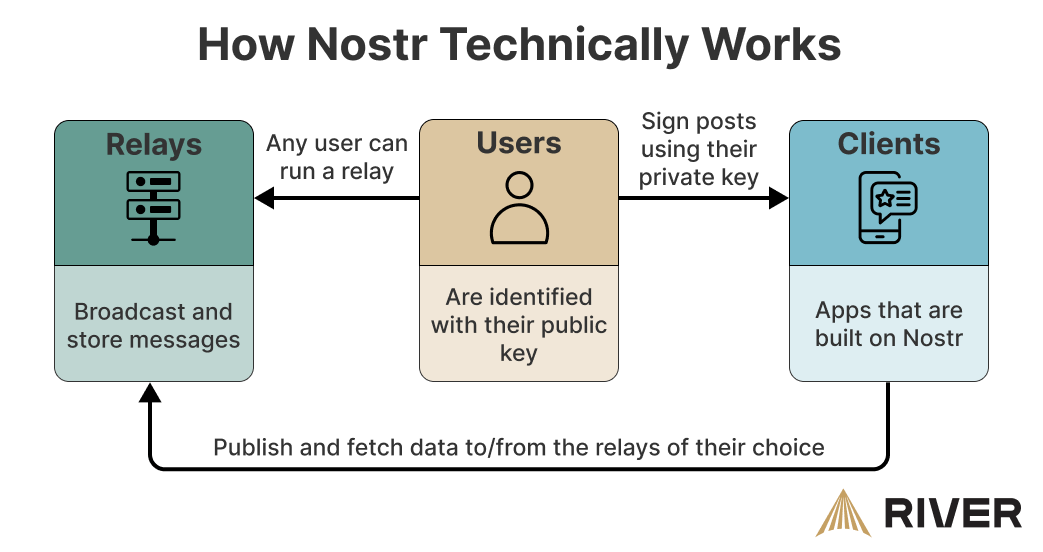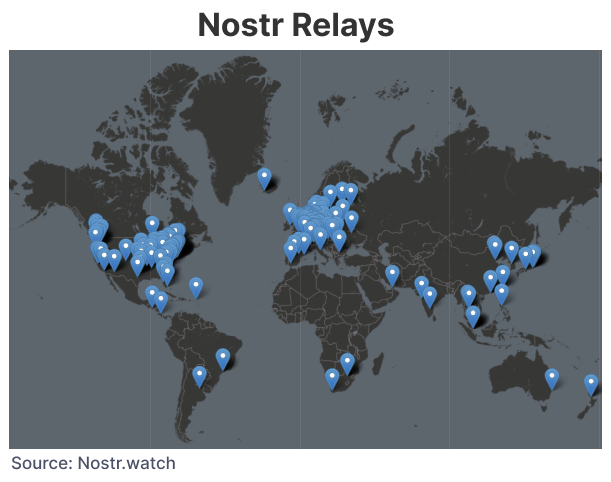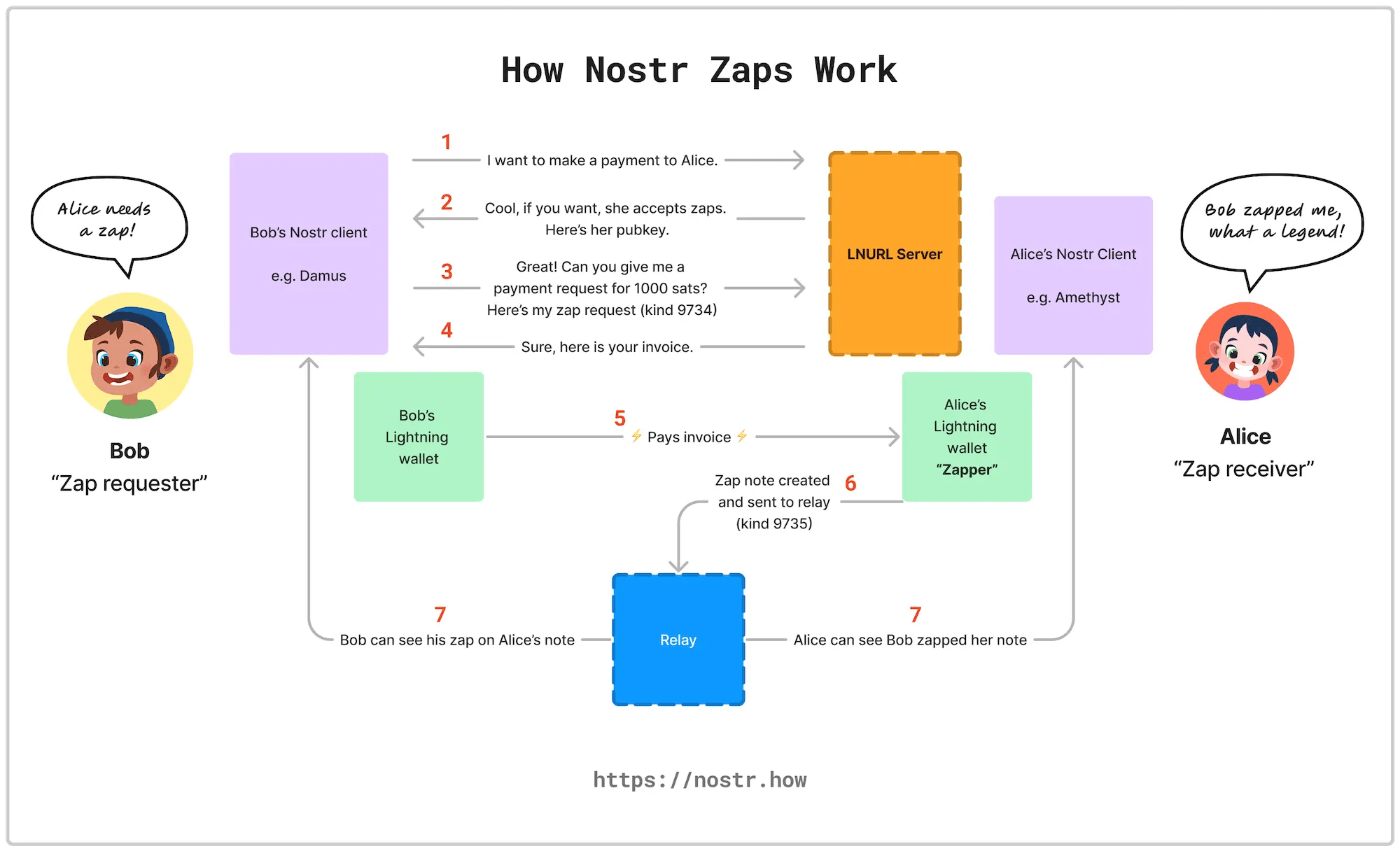Nostr is a decentralized communication protocol that stands for “notes and other stuff transmitted by relays.” Similar to Bitcoin, Nostr relies on a network of users, is open-source, and gains value from its censorship-resistant nature.
Nostr offers an alternative to traditional social media platforms. It addresses issues like spam, proprietary algorithms, and censorship. Bitcoin synergizes with Nostr, acting as the network’s native currency. This article explores the fundamentals of Nostr and decentralized social media, highlights Nostr’s similarities with Bitcoin, and examines Bitcoin’s role in the future of social platforms.
How Does Nostr Work?
Nostr is based on a simple design. Messages are exchanged between clients (apps) and relays. A relay, akin to a Bitcoin node, acts as a basic server that stores and broadcasts published content. Anyone can host a relay, and users can choose to follow or ignore any relay. Relays can set their own rules and policies for the information they broadcast. The glue that holds this system together is the Nostr protocol, defining how messages are sent and fetched across the network.

Due to its decentralized nature, Nostr allows information to be interoperable between applications. This means users can use different social media apps and still access the same content. A key advantage of this design is that no single application owns user data. If users want to switch apps, they can transfer all their data to a new one.
River is active on Nostr; we maintain an account on Primal, a popular social media client.
What Issues Does Nostr Address?
Most social media platforms today are owned and operated by private corporations, which have full control over what can and cannot be shared. This structure has raised several concerns that Nostr aims to address:
- Censorship: The restriction of speech on social media is becoming increasingly apparent. Ahead of the May 2023 presidential elections, the Turkish government pressured Twitter to restrict access to certain accounts critical of President Recep Tayyip Erdoğan and his administration. Twitter complied with these requests to ensure the platform remained available in Turkey during the critical election period. While privately-run corporations like Twitter can censor content at their discretion, Nostr provides a censorship-resistant alternative. Its decentralized architecture prevents individual actors from restricting content.
- Proprietary Algorithms: Traditional social media platforms typically use proprietary algorithms to curate and prioritize content in users’ feeds. If a user doesn’t like how their content is curated, they are often unable to change how their feed is displayed. Nostr clients display messages chronologically or based on user-defined criteria, removing the influence of opaque algorithms that could manipulate user engagement and visibility of posts.
- Spam: Spam is a challenge faced across all social media platforms. Nostr users may encounter spam similar to traditional apps. However, the prevalence of spam on Nostr may be significantly reduced in the near future as clients experiment with strategies such as requiring proof-of-work with each broadcasted message, limiting the relays they interact with, and verification badges like MicroStrategy Orange.
Who Runs Nostr Relays?
Nostr depends on relays to broadcast and store messages across the network. Nostr.watch serves as a directory of all relays with established network connections. Most relays are operated by organizations or companies, who are likely incentivized to promote the network’s success or run adjacent services such as a client or payments service. Individuals can also run a relay to store a copy of all their Nostr posts and interactions. For those interested in setting up a Nostr relay, André Neves has written an excellent guide.

How Are Nostr and Bitcoin Similar?
Bitcoin and Nostr are related primarily through their shared emphasis on decentralization and security. In fact, Nostr was originally published in 2020 by Bitcoin Core developer fiatjaf. Here are the most important similarities between Bitcoin and Nostr:
- Cryptography: To prevent relays from misrepresenting published data, Nostr employs the same public-private key cryptography used in Bitcoin. While Bitcoin uses cryptographic signatures to secure transactions, Nostr uses these principles to secure messages and user identities.
- Decentralization: Bitcoin operates on a decentralized blockchain, where no single entity controls the network. Similarly, Nostr is designed to be a decentralized messaging network, where information is sent across relays rather than being controlled by a central authority.
- Censorship Resistance: Bitcoin transactions cannot be easily stopped or altered by governments or institutions. Nostr aims to provide a censorship-resistant platform for communication, ensuring that users can freely share information without fear of being shadow-banned or censored.
- Open Source: Both Bitcoin and Nostr are open-source projects. This allows anyone to contribute to their development, ensuring transparency in these systems’ operations. Nostr’s code repository is hosted on GitHub.
How Is Bitcoin Used on Nostr?
Bitcoin is the de-facto native currency of Nostr, used for payments and content monetization:
- Bitcoin Tipping: Nostr users can send and receive Bitcoin tips, known as “Zaps”, directly within the platform. This is facilitated by Bitcoin’s Lightning Network, allowing for instant and low-fee transactions. To date, over 3 million zaps have been sent across Nostr.

- Funding and Donations: Content creators and developers on Nostr can receive donations in bitcoin. They can share their Bitcoin or Lightning Network address, enabling supporters to send funds directly to them.
- Payment for Services: Freelancers and service providers on Nostr can accept bitcoin payments for their work. This provides a decentralized and censorship-resistant way to conduct business transactions.
- Integration with Bitcoin Wallets: Some Nostr clients may integrate directly with Bitcoin wallets, making it easy for users to manage their bitcoin holdings and transactions within the same platform.
How Do I Use Nostr?
If you want to use Nostr, it’s easy to get started by following these steps:
- Have a basic understanding of how Nostr works.
- Find a client you like. Popular social media applications include Amethyst, Damus, Iris, and Primal. Blogstack is a Nostr-based blogging website. NostrChat is a chat application similar to WhatsApp or Telegram. Alby is a web-extension that integrates your bitcoin and Nostr wallets. Zap.stream is a live streaming service that allows content creators to earn bitcoin while streaming.
- Set up an account with a client. Typically, the setup process on an application involves generating public and private Nostr keys.
- Make sure you understand the basics of key management, as your Nostr private key is like a password that cannot be changed. If someone else gains access to your private key, there is no way to prevent them from accessing your accounts. Backing up your keys by storing them in a secure location is best practice.
- Begin engaging with the community. Nostr.directory is a useful resource to find the most popular accounts.
Key Takeaways
- Nostr is a decentralized communication protocol that stands for "notes and other stuff transmitted by relays."
- Bitcoin and Nostr are related primarily through their shared emphasis on decentralization and security. Bitcoin synergizes with Nostr, acting as the network's native currency.
- Nostr is based on a simple design. Messages are exchanged between clients (apps) and relays.


